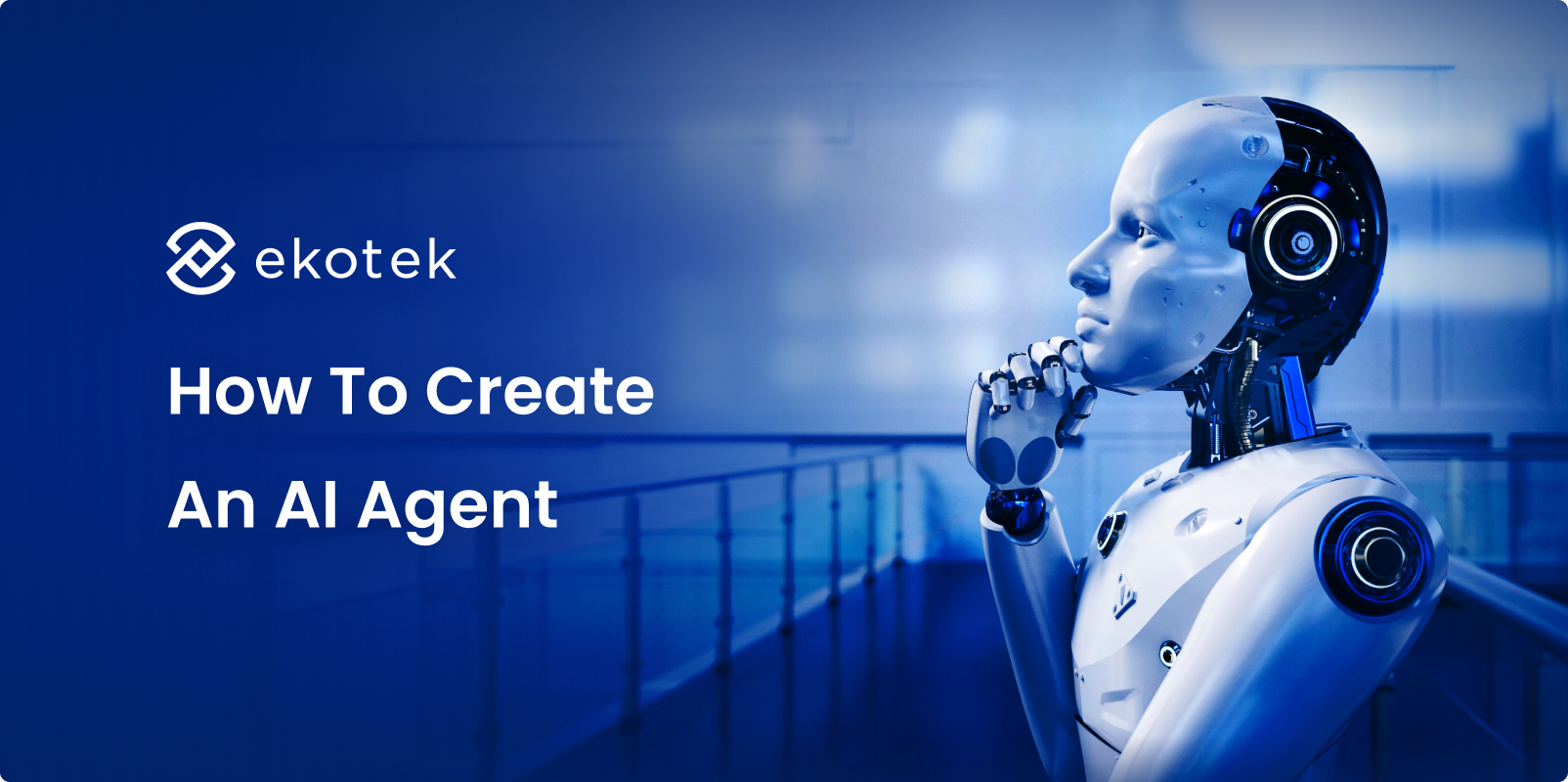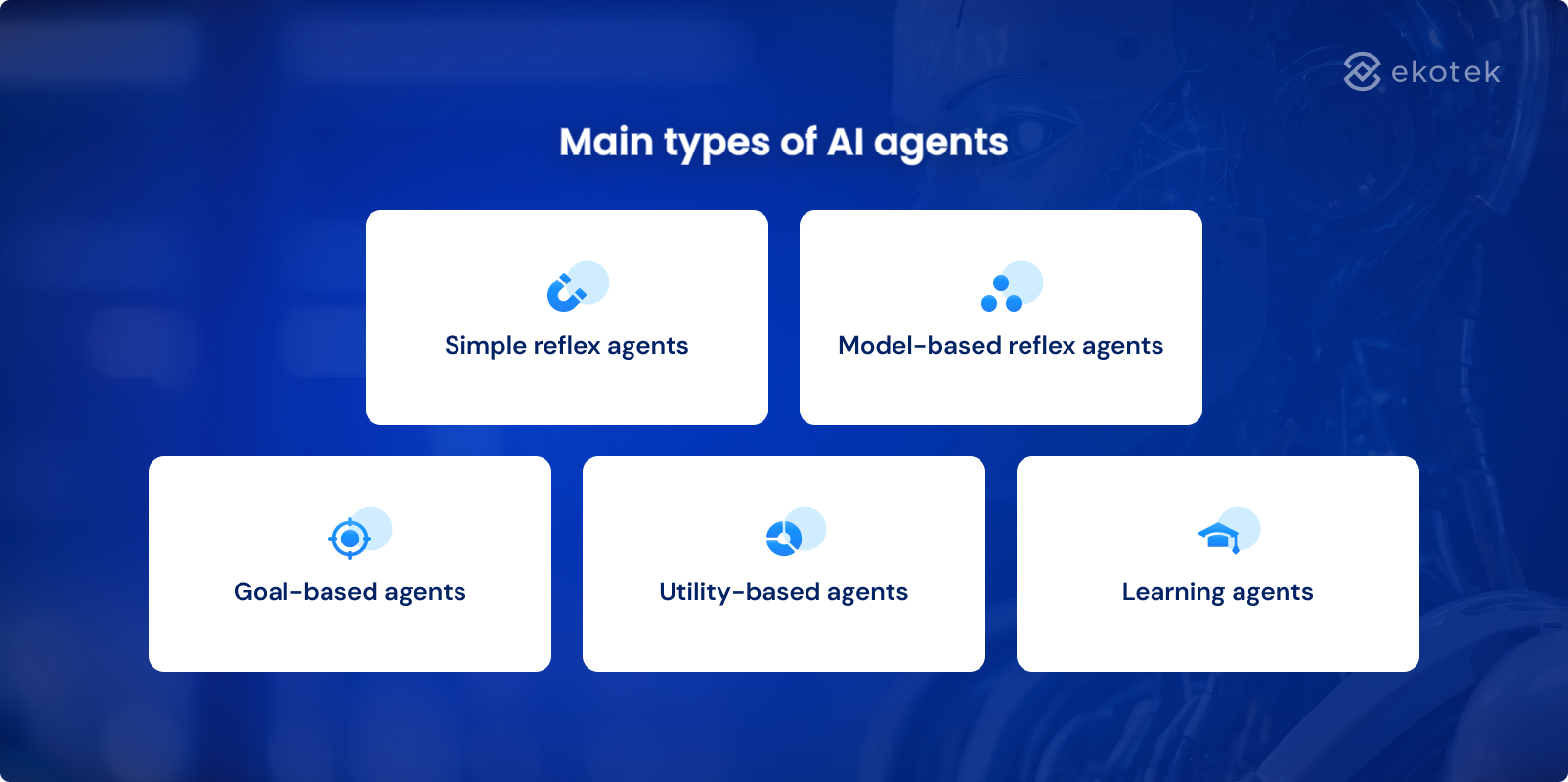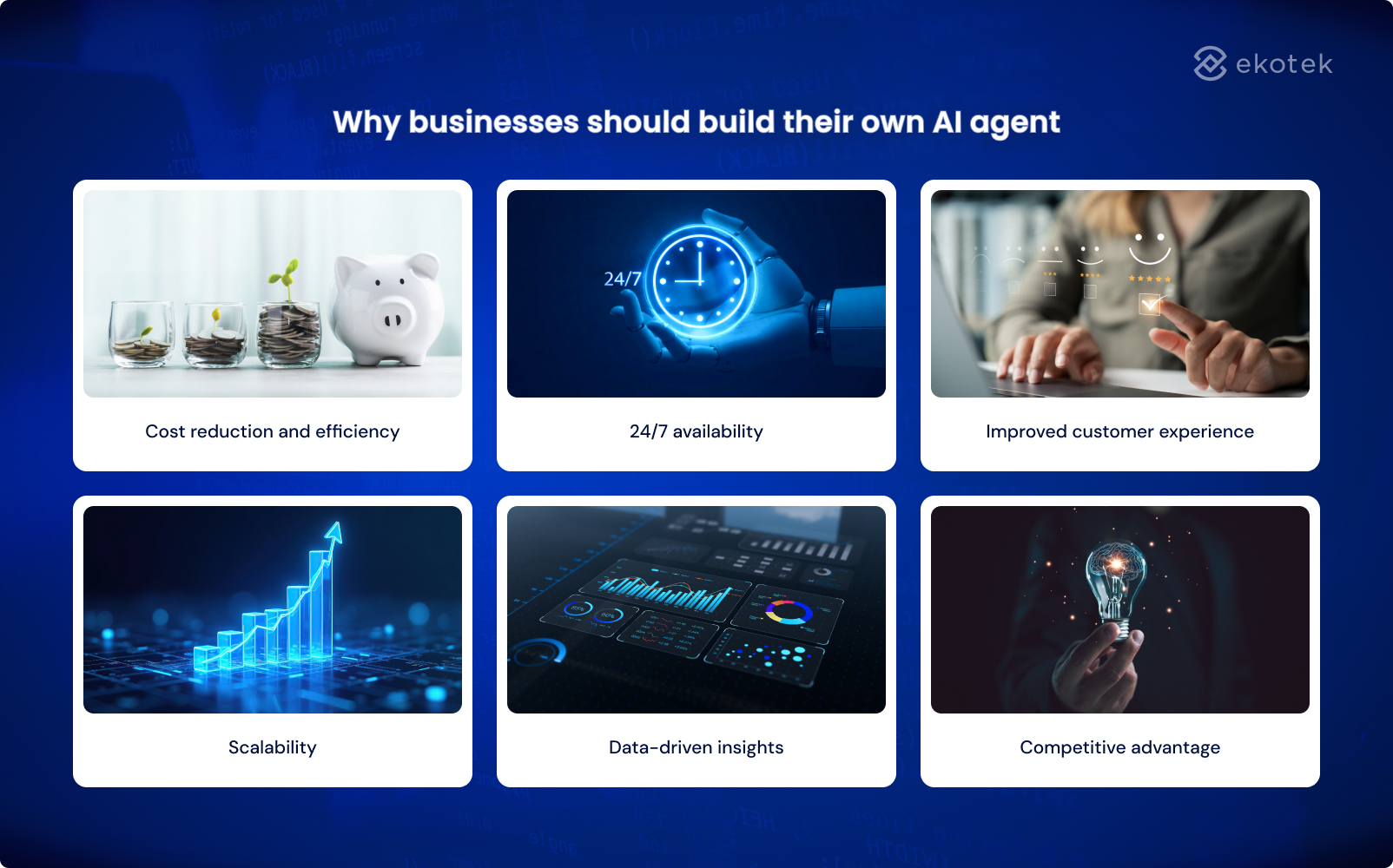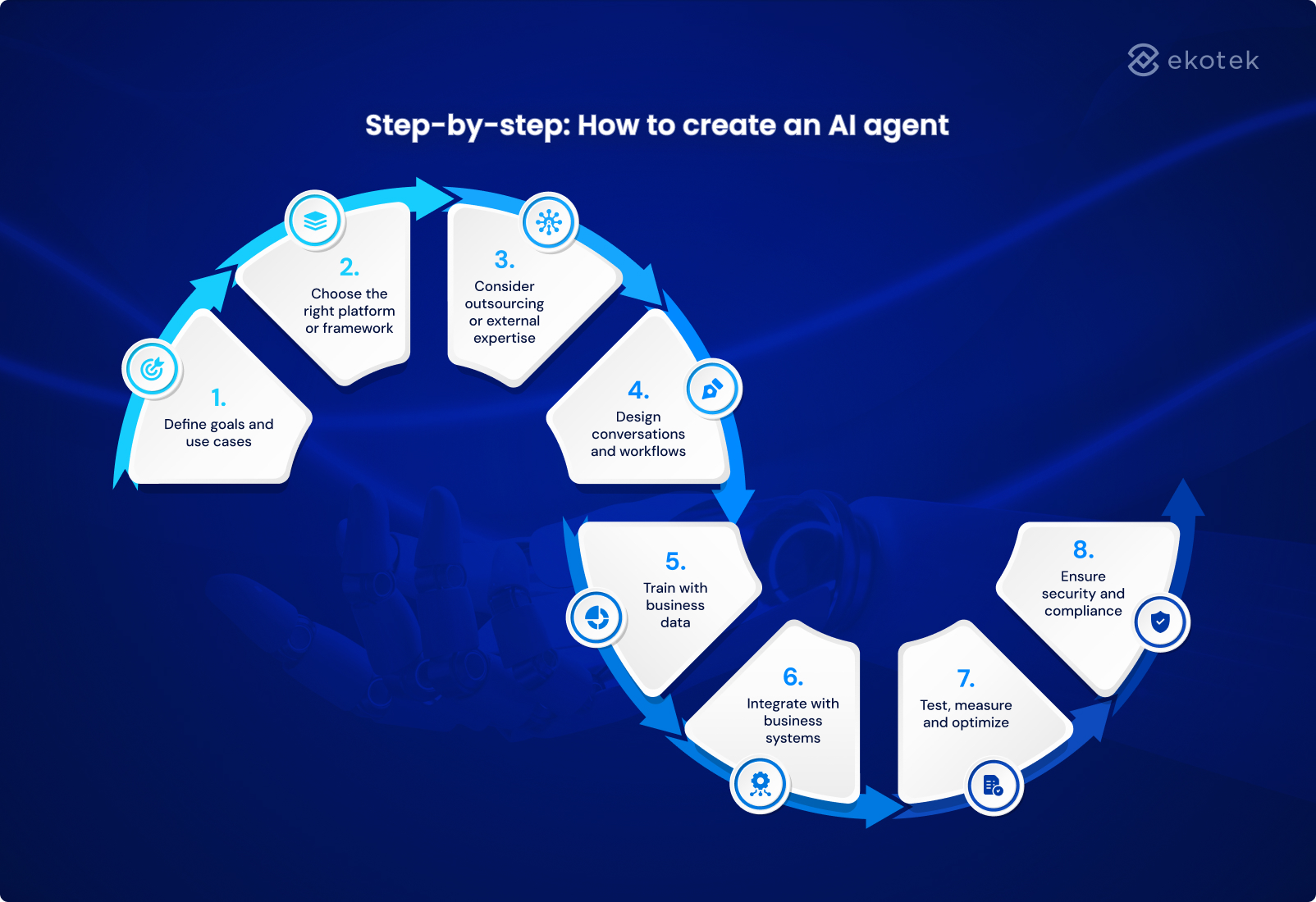
- 1
- 2
- 3
- 4
- 5
- 6
- 7
- 8
Artificial intelligence (AI) has moved beyond experimentation and become a core driver of business transformation. Among its many applications, AI agents are rapidly gaining traction across industries, from customer service chatbots to workflow automation assistants.
Recent reports show that over 80% of enterprises are already experimenting with AI-driven solutions, and those that leverage AI agents report measurable gains such as reduced costs, improved customer satisfaction, and faster decision-making.
In this article, we’ll explore how to create an AI agent step by step, giving your business a practical roadmap to unlock the full potential of this technology.
What is an AI agent?
An AI agent is an intelligent software program that can observe information, analyze it, and act toward a goal. Unlike traditional automation tools that only follow fixed rules, AI agents can adapt, learn, and improve over time.
For businesses, this means moving beyond simple rule-based systems to solutions that can:
- Understand customer intent instead of just matching keywords.
- Automate complex workflows that normally require human input.
- Continuously get smarter as they process more data.
💡 Discover why Crypto AI agents could transform the future of decentralized technology
Main types of AI agents
 Simple reflex agents
Simple reflex agents
These are the most basic types of AI agents. They respond directly to the current situation without considering any past information. Their behavior is based entirely on predefined rules such as “if this happens, then do that.”
- How they work: React only to present input, with no memory of previous states.
- Business example: A simple FAQ chatbot that can instantly answer “What are your working hours?” but cannot handle follow-up questions.
- Best use case: Handling straightforward, repetitive queries where context is not important.
Model-based reflex agents
Unlike simple reflex agents, these agents take past information into account when making decisions. They build a partial “model” of the world to improve their responses.
- How they work: Use both current input and stored knowledge of past states.
- Business example: A system monitoring server performance that alerts IT teams when usage patterns deviate significantly from historical trends.
- Best use case: Operational monitoring or quality control tasks where historical context improves accuracy.
Goal-based agents
These agents go beyond reactive responses by focusing on achieving a specific objective. Instead of simply following rules, they evaluate different actions to see which ones move them closer to a desired goal.
- How they work: Select actions by measuring their contribution to achieving the defined goal.
- Business example: A sales assistant bot that interacts with leads, asking questions and guiding conversations with the ultimate goal of scheduling a product demo.
- Best use case: Sales, marketing, or customer service scenarios where reaching a clear outcome matters more than quick reactions.
Utility-based agents
While goal-based agents focus on reaching an objective, utility-based agents add another dimension: they evaluate the quality of outcomes and choose the option that delivers the greatest value.
- How they work: Consider multiple possible outcomes and prioritize those with the highest overall utility.
- Business example: An e-commerce recommendation engine that not only suggests relevant products but also factors in profitability or stock availability to maximize business value.
- Best use case: Environments where trade-offs must be managed, such as pricing optimization, product recommendations, or resource allocation.
Learning agents
The most advanced type, learning agents, can improve their performance over time. By analyzing past experiences, they adapt their behavior and become more effective with each interaction.
- How they work: Continuously learn from feedback, data, and outcomes to refine decision-making.
- Business example: A customer service AI that gradually becomes better at resolving complex queries as it learns from thousands of past conversations.
- Best use case: Dynamic, fast-changing industries where customer needs and data evolve rapidly.
💡 See how AI integration can streamline your business operations
Why businesses should build their own AI agent
 Cost reduction and efficiency
Cost reduction and efficiency
AI agents excel at automating repetitive and low-value tasks, from answering standard customer inquiries to processing internal requests. By taking over these functions, businesses can reduce labor costs, free up employees for higher-value work, and minimize errors caused by manual processes.
24/7 availability
Unlike human employees, AI agents never sleep. They can operate continuously, providing immediate responses to customers or employees at any time of day. This is especially valuable for businesses that serve global markets or rely on round-the-clock operations.
Improved customer experience
Customers expect fast, personalized, and consistent service. AI agents meet these expectations by delivering instant responses, adapting to individual needs, and maintaining a uniform tone aligned with the brand. Over time, this builds stronger customer trust and loyalty.
Scalability
As businesses grow, so does the volume of interactions. Hiring and training additional staff for every growth phase is costly and inefficient. AI agents scale effortlessly, handling thousands of simultaneous requests without compromising quality.
Data-driven insights
Every interaction with an AI agent generates valuable data. Businesses can analyze this information to identify customer pain points, discover emerging trends, and make smarter strategic decisions. In effect, AI agents not only serve customers but also act as a continuous source of market intelligence.
Competitive advantage
Companies that embrace AI agents position themselves as innovators. They can deliver faster service, lower costs, and better customer engagement than competitors who rely solely on traditional methods. Early adoption often becomes a key differentiator in crowded markets.
💡 Discover the key differences between Generative AI and Agentic AI
Two main approaches to AI agent development
Building from scratch
This approach means designing and coding the AI agent entirely in-house. It gives companies complete control over features, architecture, and integration.
Advantages:
- Fully customizable to fit specific business requirements.
- Greater flexibility in security, data handling, and compliance.
- No dependency on third-party platforms.
Challenges:
- Requires significant AI expertise and a skilled development team.
- Higher upfront investment in both time and cost.
- Longer timelines before the solution is production-ready.
Using existing frameworks and platforms
Another option is to build on top of ready-made AI platforms such as OpenAI, Rasa, Dialogflow, or Microsoft Bot Framework. These provide pre-built tools, APIs, and models that significantly reduce development complexity.
Advantages:
- Faster to prototype and deploy compared to building from scratch.
- More cost-effective for businesses without deep AI expertise.
- Easy integration with existing business systems (CRM, ERP, e-commerce, etc.).
- Regular updates and improvements are handled by the platform provider.
Challenges:
- Less control over customization, especially for niche use cases.
- Potential dependency on vendor infrastructure and pricing models.
- Data privacy considerations when using third-party platforms.
💡 Plug ChatGPT into your workflows today, see the hands-on tutorial
Step-by-step: How to create an AI agent
 Step 1: Define goals and use cases
Step 1: Define goals and use cases
Before writing a single line of code, clarify what you want the AI agent to achieve. Is the goal to reduce customer service workload, qualify sales leads, or automate HR tasks? Clear objectives ensure alignment with business strategy and help set measurable KPIs such as “reduce support response time by 40%” or “increase lead qualification rate by 25%.”
Step 2: Choose the right platform or framework
Next, decide whether to build from scratch or leverage an existing framework. Consider:
- Cost: upfront vs. long-term.
- Scalability: will it handle future growth?
- Integration: can it connect with your current tech stack?
- Compliance: does it meet data security regulations?
Platforms like OpenAI, Rasa, Dialogflow, or Microsoft Bot Framework can accelerate time-to-market, especially for businesses without in-house AI expertise.
Step 3: Consider outsourcing or external expertise
Not every business has the in-house talent or resources to build an AI agent from scratch. Outsourcing to specialized AI development firms can accelerate timelines, reduce costs, and bring in domain expertise. When evaluating partners, look at:
- Proven track record with AI and automation projects.
- Understanding of your industry’s compliance and security requirements.
- Flexibility to deliver end-to-end solutions or augment your internal team.
Outsourcing doesn’t replace internal ownership; it complements it, allowing your business to focus on strategy while external experts handle the heavy lifting.
💡 Find vetted Vietnam-based AI agent partners for B2B growth
Step 4: Design conversations and workflows
An AI agent should feel natural and useful to the end user. Map out the customer journey or process flow that it will support. Define:
- The most common user intents (FAQs, requests, commands).
- Conversation tone and personality aligned with your brand voice.
- Escalation paths when the AI cannot resolve an issue.
This ensures the agent is not only functional but also consistent with your customer experience strategy.
Step 5: Train with business data
AI is only as good as the data it learns from. Use real business assets such as:
- Customer FAQs and chat transcripts.
- Knowledge base articles and internal documents.
- Historical service tickets or sales interactions.
By grounding the AI in your company’s domain knowledge, you ensure accurate, context-aware responses.
Step 6: Integrate with business systems
For maximum value, the AI agent must connect seamlessly with your core systems:
- CRM: to pull customer history.
- ERP or e-commerce platforms: to check order status or inventory.
- Collaboration tools: to assist employees on Slack, Teams, or email.
Integration transforms the agent from a simple chatbot into a powerful business assistant.
Step 7: Test, measure and optimize
Pilot the AI agent with a limited audience before a full rollout. Gather feedback, track performance metrics (accuracy, resolution rate, customer satisfaction), and refine accordingly. Treat the pilot as a learning cycle to prevent large-scale failures.
Step 8: Ensure security and compliance
Finally, no AI project is complete without robust governance. Ensure compliance with relevant regulations such as GDPR, HIPAA, or local data laws. Implement access controls, encryption, and audit logs. Communicating transparently with users about how their data is used, trust is critical for adoption.
Common challenges and how to overcome them
Data quality issues
AI agents rely on accurate, relevant data to perform well. Poor data, whether outdated, inconsistent, or unstructured, leads to inaccurate responses and user frustration.
How to overcome: Invest in data preparation early. This includes cleaning, labeling, and standardizing data sources. Some companies even create a dedicated “AI-ready” knowledge base to ensure the agent learns from reliable information.
High initial costs
Developing AI agents, especially from scratch, can require substantial investment in technology, infrastructure, and talent. For many businesses, the cost appears daunting.
How to overcome: Start small with a pilot project focused on a single use case (e.g., automating FAQs). Prove value quickly, then scale gradually to more complex workflows once ROI is demonstrated.
Customer adoption barriers
Not all customers immediately embrace AI-driven interactions. Some may distrust automated responses or prefer speaking to a human representative.
How to overcome: Implement a hybrid support model where the AI agent handles routine queries while seamlessly transferring complex cases to human agents. Transparency is key, let users know they can always reach a person if needed.
Integration complexity
AI agents often need to connect with existing business systems (CRM, ERP, or legacy platforms). Poor integration can lead to data silos and inconsistent customer experiences.
How to overcome: Choose frameworks that support APIs and middleware for easy integration. Work closely with IT teams or external partners to ensure smooth connectivity.
Security and compliance risks
AI agents process sensitive data, making them a target for breaches or misuse. Failure to comply with regulations like GDPR or HIPAA can lead to reputational and financial damage.
How to overcome: Establish strong data governance practices. Encrypt sensitive data, enforce role-based access, and run regular compliance audits.
Ekotek’s AI agent in production (BOM automation)
If you’re exploring how to create an AI agent that delivers real ops impact, here’s a quick snapshot from Ekotek’s footwear client. A global manufacturer struggled with a multi-team, error-prone BOM workflow.
What it does:
- Fuses Computer Vision + NLP to read shoe drawings, supplier PDFs, and past BOMs, then proposes or auto-generates BOMs.
- Built on NextJS, OpenCV, Python, MySQL; delivered in about 6 months.
Why it matters:
- Cuts manual workload, streamlines design-to-BOM, and improves accuracy and efficiency across teams.
📌 Get the full story and technical details of our AI agent case study
Conclusion and future outlook
AI agents are no longer futuristic, they’re practical, scalable tools delivering real business value today. By following a structured development process, your organization can cut costs, improve customer experiences, and stay ahead of competitors.
Looking forward, the rise of multi-agent systems and generative AI-powered agents will further expand business opportunities, enabling AI to handle even more complex tasks and decision-making.
Ekotek delivers end-to-end AI development, strategy, data preparation, custom build, integration, and ongoing optimization, so your solutions are secure, scalable, and maintainable. With cross-industry experience (manufacturing, finance, retail, education) and a framework-agnostic approach, we tailor the right mix of models and engineering to your context. Whether you’re automating workflows, deploying conversational interfaces, or defining how to create an AI agent for your operations, we bring the technical depth and delivery discipline to move from concept to impact.
Let’s talk about what you want to build next.
- 1
- 2
- 3
- 4
- 5
- 6
- 7
- 8